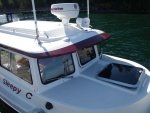Cutty Sark
New member
I was doing some winter reading and planning, for a couple weekend trips to the SJ's, and came across some instructions to use a vhf channel with an A in it. For example channel 66A to contact a marina. I have never seen this function on my VHF. I have a model that is only about two years old. Am I missing something? I'm feeling pretty silly right now. How do you switch to an "A" channel? Thanks for any help. It's a west Marine model radio.
Sark
Sark

